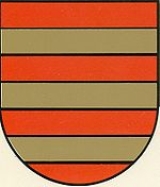
Count of Santa Cruz
Encyclopedia
Count of Santa Cruz was a Portuguese title of nobility created by a royal decree of King Philip II of Portugal, also known as Philip III of Spain
, dated from October 3, 1593, and granted to Francisco de Mascarenhas (1530-1608), nephew of Dom
Pedro de Mascarenhas, 6th Viceroy
of Portuguese India
.
Through a remarkable marriage policy, this family inherited several other titles and estates, such as Marquis of Gouveia in 1686, and Duke of Aveiro
in 1745.
Philip III of Spain
Philip III , also known as Philip the Pious, was the King of Spain and King of Portugal and the Algarves, where he ruled as Philip II , from 1598 until his death...
, dated from October 3, 1593, and granted to Francisco de Mascarenhas (1530-1608), nephew of Dom
Don (honorific)
Don, from Latin dominus, is an honorific in Spanish , Portuguese , and Italian . The female equivalent is Doña , Dona , and Donna , abbreviated "Dª" or simply "D."-Usage:...
Pedro de Mascarenhas, 6th Viceroy
Viceroy
A viceroy is a royal official who runs a country, colony, or province in the name of and as representative of the monarch. The term derives from the Latin prefix vice-, meaning "in the place of" and the French word roi, meaning king. A viceroy's province or larger territory is called a viceroyalty...
of Portuguese India
Portuguese India
The Portuguese Viceroyalty of India , later the Portuguese State of India , was the aggregate of Portugal's colonial holdings in India.The government started in 1505, six years after the discovery of a sea route to India by Vasco da Gama, with the nomination of the first Viceroy Francisco de...
.
Through a remarkable marriage policy, this family inherited several other titles and estates, such as Marquis of Gouveia in 1686, and Duke of Aveiro
Duke of Aveiro
The Royal Dukedom of Aveiro was an aristocratic Portuguese title, granted in 1535 by King John III of Portugal to his 4th cousin, John of Lencastre, son of Infante George of Lencastre, a natural son of King John II of Portugal....
in 1745.
List of the Counts of Santa Cruz
- Francisco Mascarenhas (1530-1608), 1st Count of Vila da HortaCount of Vila da HortaThe Count of Vila da Horta was a title created by Philip I of Portugal in 1585 in favor of Francisco de Mascarenhas. The first count was lost the captaincy of the island of Fail and demanded with the Royal Family, Philip I substituted the title with the count of Santa Cruz conceded the title as a...
and 13th Viceroy of Portuguese India; - Martinho Mascarenhas (1570 - ?), 2nd Count of Santa Cruz;
- Beatriz Mascarenhas (1610 - ? ), 3rd Countess of Santa Cruz. She married a distant cousin, João de Mascarenhas (1600-1668), who became 3rd Count of Santa Cruz by marriage;
- Martinho Mascarenhas (1630-1676), 4th Count of Santa Cruz;
- João Mascarenhas (1650-1691), 5th Count of Santa Cruz;
- Martinho Mascarenhas (1681-1723), 6th Count of Santa Cruz and 3rd Marquis of Gouveia;
- João Mascarenhas (1699- ? ), 7th Count of Santa Cruz and 4th Marquis of Gouveia, forced to renounce the title after fleeing Portugal for adultery, he chose to live maritally with his mother;
- José Mascarenhas da Silva e Lencastre (1708-1759), 8th Count of Santa Cruz, 5th Marquis of Gouveia and 8th Duke of AveiroDuke of AveiroThe Royal Dukedom of Aveiro was an aristocratic Portuguese title, granted in 1535 by King John III of Portugal to his 4th cousin, John of Lencastre, son of Infante George of Lencastre, a natural son of King John II of Portugal....
; - Martinho Mascarenhas (1740-1804), 9th Count of Santa Cruz and 6th Marquis of Gouveia. The last Count of Santa Cruz before the title was extinct following the Tavora affairTávora affairThe Távora affair was a political scandal of the 18th century Portuguese court. The events triggered by the attempted murder of King Joseph I of Portugal in 1758 ended with the public execution of the entire Távora family and its closest relatives in 1759...
.

